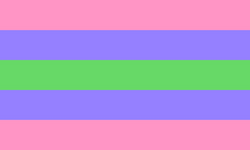Trigender
| |
This page is about a gender identity that is not widely used among gender-variant people. This does not mean that the identity is not valid, but that very few people are known to use this term. More information on uncommon identities... |
 | |
| Related identities | Polygender and Bigender |
|---|---|
| Under the umbrella term | Multigender |
| Frequency | 0.1% |
| Click here to see alternative flags! | |
Trigender people experience three genders, at the same time, or moving between the three at different times.[1][2] These three genders can be any gender, either binary or nonbinary.[3] A trigender person may change from expressing one gender to another, depending on that person's mood or situation.[4] Someone who identifies as trigender may feel that their gender is a combination of several genders happening at the same time.[5] Trigender falls under the general categories of multigender (having many genders) and sometimes genderfluid (having genders that change from time to time). It can also be considered a type of genderqueer or nonbinary identity, which goes beyond the Western binary gender system,[4] much as can be seen in cultures that recognize individuals' right to define their own sense of self[6]
In most Western societies, straying outside of the gender dichotomy is seen as socially unacceptable to the patriarchy.[6][7] The term third gender has been applied to to many kinds of people, even to white Westerners themselves, who do not conform into rigid categories of heterosexual roles and gender-conforming men and women. The phrase "third gender" has been used for a wide variety of meanings: intersex people whose bodies do not fit outdated Western medical concepts of binary sex, hundreds of indigenous societal roles as described (and often misrepresented) by Western anthropologists (including indigenous identities such as south Asian hijras, Hawaiian and Tahitian māhū, and Native American identities now called Two-Spirits),[8] transgender people who are nonbinary, homosexual people even in Western societies,[9][10][11] and women who were considered to be gender-nonconforming because they fought for women's rights.[12] A significant number of nonbinary people have adopted "third gender" to describe themselves. In the 2019 Worldwide Gender Census, 2.17% (244) of the 11,242 respondants called themselves third gender.[13]
History[edit | edit source]
The word "trigender" was in use at least before 1999.[1] Trigender was mentioned as one of many valid nonbinary identities in the 2013 text Sexuality and Gender for Mental Health Professionals: A Practical Guide.[14] In the 2019 Worldwide Gender Census, 14 respondents called themselves trigender.[13]
See also[edit | edit source]
References[edit | edit source]
- ↑ 1.0 1.1 Leslie Feinberg, Trans Liberation: Beyond Pink Or Blue, page 53-4, Beacon Press, 1999, ISBN 0-8070-7951-0, ISBN 978-0-8070-7951-5.
- ↑ Alexia Elejalde-Ruiz, "For the young, gender is fluid", Chicago Tribune, November 18, 2009. Archived on 17 July 2023
- ↑ Maurianne Adams, Lee Anne Bell, Pat Griffin, Teaching for diversity and social justice, page 224,CRC Press, 2007, ISBN 0-415-95200-X, 9780415952002.
- ↑ 4.0 4.1 Gilbert H. Herdt, Third sex, third gender: beyond sexual dimorphism in culture and history, Zone Books, 1996, ISBN 0-942299-82-5, ISBN 978-0-942299-82-3.
- ↑ Alexia Elejalde-Ruiz, "For the young, gender is fluid", Chicago Tribune, November 18, 2009.
- ↑ 6.0 6.1 Leslie Bentz, "The Neurobiology of Gender Bending", Bryn Mawr , 2005.
- ↑ Stephen Marc Beaudoin, "And Another Barrier is Broken: Meet Silverton, Oregon’s Gender-Fluid, Trans-Identified Mayor-Elect, Stu Rasmussen", Just Out, November 6th, 2008.
- ↑ Julia Serano, Whipping Girl: A Transsexual Woman on Sexism and the Scapegoating of Femininity. Unpaged.
- ↑ Trumbach, Randolph. (1998) Sex and the Gender Revolution. Volume 1: Heterosexuality and the Third Gender in Enlightenment London. Chicago: U of Chicago P, 1998. (Chicago Series on Sexuality, History & Society)
- ↑ Ross, E. Wayne (2006). The Social Studies Curriculum: Purposes, Problems, and Possibilities. SUNY Press. ISBN 978-0-7914-6909-5.
- ↑ Kennedy, Hubert C. (1980) The "third sex" theory of Karl Heinrich Ulrichs, Journal of Homosexuality. 1980–1981 Fall–Winter; 6(1–2): pp. 103–1
- ↑ Wright, B. D. (1987). ""New Man," Eternal Woman: Expressionist Responses to German Feminism". The German Quarterly. 60 (4): 582–599. doi:10.2307/407320. JSTOR 407320.
- ↑ 13.0 13.1 "Gender Census 2019 - the worldwide TL;DR." Gender Census. March 31, 2019. Retrieved July 5, 2020. https://gendercensus.com/post/183843963445/gender-census-2019-the-worldwide-tldr Archive: https://web.archive.org/web/20200118084451/https://gendercensus.com/post/183843963445/gender-census-2019-the-worldwide-tldr
- ↑ Richards, Christina; Barker, Meg (2013). Sexuality and Gender for Mental Health Professionals: A Practical Guide. SAGE Publications. ISBN 9781446293133.
